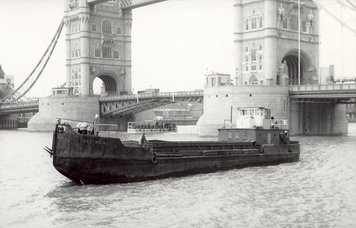Spithead
In action
SPITHEAD was one of 200 motor landing craft specially designed and built for the Gallipoli campaign in 1915. Twenty seven yards in the north east of England and 3 on the Clyde were appointed to construct them. Some were designed as water lighters, whilst others were designed to carry troops, horses, field guns and stores. SPITHEAD was built by Osbourne Graham & Co. Ltd of Sunderland in 1915 and she was designated X-44.
The north east built X-lighters were taken to the delivery port of Immingham on the River Humber, where they were checked and any modifications made if necessary. They were then towed to Devonport, up to three at a time. Those for service at Gallipoli were subsequently taken to the Mediterranean with colliers from Cardiff and merchant ships, stopping off at Malta for a couple of days before proceeding to the large natural harbour of Mudros on the Aegean Island of Lemnos. The tow from Devonport took about 25 days.
On arrival in the Aegean the 14 water lighters were given an ‘L’ number from L-1 to L-14, and the troop and horse lighters were given a ‘K’ number, from K-1 to K-77. Thus the total number of X-lighters that reached the Aegean was 91; this meant that one hundred and nine did not do so. One, X-130, was sunk by the German submarine U-33 along with her towing vessel the Burrsfield. The others, including SPITHEAD, remained based in England, and did not make it further than the French coast.
Whilst serving at Gallipoli, nine of the ‘K’ lighters were lost; however, all 144 ‘L’ lighters survived. They remained in theatre for the duration of the campaign, and took part in the successful withdrawal of troops, animals and equipment in early January 1916. After withdrawal the X-lighters were dispersed to Constantinople, Lemnos, Salonika, Gibraltar and Egypt. Two were taken by sea to Bombay.
From 1920 many of the X-lighters used at Gallipoli were sold to private firms and shipping agents, and to the governments of France, Egypt and Greece. Twenty-seven were used in the north Russian campaign of 1919, when three were lost. A further twenty-six were sold to the Spanish government, of which 11 survived the Spanish Civil War of 1936-39.
Sixteen of the lighters, five of which were the water L-lighters, were taken back to Malta, which had been the support base for the Gallipoli campaign. Five of the UK-based X-lighters were later used in the Dunkirk evacuation; all of these returned safely to Ramsgate.

Where is she now?
SPITHEAD was sold by the Admiralty in 1921; she was bought by the James Dredging & Towage Co. who used her until 1936. She was then sold to F. W. Horlock Ocean Transport Ltd. and carried aggregate on the East Coast and River Thames. During the Second World War she was requisitioned by the Admiralty and used as a fleet tender at Scapa Flow. Afterwards she was returned to her previous owners and duties.
SPITHEAD later changed hands many times, continuing in the ballast trade; her last commercial use was as a dive/salvage vessel in the 1970s. Since the 1980s, SPITHEAD has been used as a houseboat. Major restoration was undertaken in 2009. She is now based at Sandwich in Kent.
Sources
David Mallard, X-Lighters - The Black Beetles.
